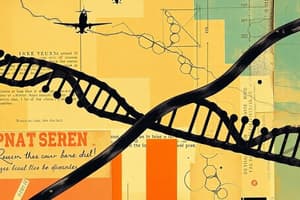Podcast
Questions and Answers
What is the function of ribosomes?
What is the function of ribosomes?
Ribosomes are the organelles that assemble amino acids into proteins.
Which of the following is NOT a function of RNA?
Which of the following is NOT a function of RNA?
- Aid in protein synthesis
- Store genetic information (correct)
- Carry genetic information from DNA to ribosomes
- Provide structural support for cells
Transcription occurs in the cytoplasm of eukaryotic cells.
Transcription occurs in the cytoplasm of eukaryotic cells.
False (B)
What is the name of the enzyme that carries out transcription?
What is the name of the enzyme that carries out transcription?
Which of the following is NOT a step in gene expression?
Which of the following is NOT a step in gene expression?
What is the function of a promoter in DNA?
What is the function of a promoter in DNA?
What is the name of the process by which introns are removed from a newly transcribed RNA molecule?
What is the name of the process by which introns are removed from a newly transcribed RNA molecule?
What is the function of a poly-A tail added to a mature mRNA?
What is the function of a poly-A tail added to a mature mRNA?
Which type of RNA carries the genetic code from DNA to ribosomes for protein synthesis?
Which type of RNA carries the genetic code from DNA to ribosomes for protein synthesis?
A set of three consecutive nucleotides in an mRNA molecule that codes for a specific amino acid is called a ______.
A set of three consecutive nucleotides in an mRNA molecule that codes for a specific amino acid is called a ______.
Match the following types of RNA with their primary function:
Match the following types of RNA with their primary function:
Flashcards
Ricin
Ricin
A highly toxic protein from the castor oil plant, lethal in small doses with no antidote.
Gene
Gene
A segment of DNA that encodes instructions for building RNA or protein products.
Transcription
Transcription
The process of synthesizing RNA from a DNA template.
mRNA
mRNA
Signup and view all the flashcards
Translation
Translation
Signup and view all the flashcards
Ribosome
Ribosome
Signup and view all the flashcards
tRNA
tRNA
Signup and view all the flashcards
Codon
Codon
Signup and view all the flashcards
Genetic code
Genetic code
Signup and view all the flashcards
Start codon
Start codon
Signup and view all the flashcards
Stop codons
Stop codons
Signup and view all the flashcards
Ribosomal RNA (rRNA)
Ribosomal RNA (rRNA)
Signup and view all the flashcards
Introns
Introns
Signup and view all the flashcards
Exons
Exons
Signup and view all the flashcards
Alternative splicing
Alternative splicing
Signup and view all the flashcards
Poly-A tail
Poly-A tail
Signup and view all the flashcards
Promoter
Promoter
Signup and view all the flashcards
RNA polymerase
RNA polymerase
Signup and view all the flashcards
Peptide bond
Peptide bond
Signup and view all the flashcards
Mutations
Mutations
Signup and view all the flashcards
Base-pair substitution
Base-pair substitution
Signup and view all the flashcards
Frameshift mutation
Frameshift mutation
Signup and view all the flashcards
Sickle-cell anemia
Sickle-cell anemia
Signup and view all the flashcards
Hemoglobin
Hemoglobin
Signup and view all the flashcards
Eukaryotes
Eukaryotes
Signup and view all the flashcards
Prokaryotes
Prokaryotes
Signup and view all the flashcards
Study Notes
Ribonucleic Acid (RNA) and Protein Synthesis
- RNA is a crucial molecule in protein synthesis
- It's similar to DNA but single-stranded
- RNA nucleotides have ribose sugar, phosphate groups, and four bases (adenine, uracil, cytosine, guanine)
- Three main types of RNA involved in protein synthesis: mRNA (messenger), tRNA (transfer), and rRNA (ribosomal)
Ribosome Inactivating Proteins (RIPs)
- Ricin is a highly toxic naturally occurring protein
- Kills by inactivating ribosomes, essential for protein synthesis, in cells
- Effectively deters insects, birds, mammals etc. from eating castor oil plant seeds
- Ricin production is a concern as a weapon; no antidote
- Used in past terrorist attacks and plots
- A ribosome-inactivating protein (RIP) occurs naturally in some bacteria, mushrooms, algae and other plants
- Includes food crops like tomatoes, barley, spinach
Gene Expression
- Genes carry instructions for building proteins
- DNA holds genetic information
- Information in a gene is converted to RNA (transcription)
- Then converts information in mRNA into a protein (translation)
- DNA is like an encyclopedia
- RNA is like a disposable copy of a gene
- Transcription converts DNA info into RNA, through RNA polymerase
- Translation converts RNA into a polypeptide
- Polypeptide folds into a protein
- Proteins perform various life processes
Transcription (DNA to RNA)
- RNA polymerase is the main enzyme
- Requires a promoter sequence on DNA for binding
- Non-coding DNA strand acts as a template to make RNA
- RNA is assembled from RNA nucleotides
- Base-pairing rules govern assembly
Translation (RNA to Protein)
- Ribosomes (comprised of rRNA and proteins) assemble polypeptide chains
- Takes place in cytoplasm
- Genetic code (codon-amino acid pairings) dictates order of amino acids
- tRNAs deliver amino acids to ribosomes
- Ribosomes connect amino acids with peptide bonds
- Translation ends when a stop codon is reached
Mutated Genes and Protein Products
- Mutations can lead to changes in a gene's product
- Base-pair substitutions
- Deletion or insertion of base pairs cause frameshift mutations that alter the entire amino acid sequence
- Examples: Sickle-cell anemia, beta-thalassemia
- Mutations can result in a variety of diseases, including various cancers
Studying That Suits You
Use AI to generate personalized quizzes and flashcards to suit your learning preferences.




